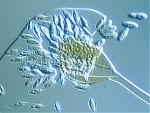Rhopalomyces
RHOPALOMYCES Corda, 1839 (Practflora, p. 3), 7 or 8 species + 3 varieties (Stalpers, 1974—transferred many species of Rhopalomyces to Oedocephalum). NOTE: Rhopalomyces Harder & Sörgel is a synonym of Blastocladiella Mathews (Couch and Whiffen, 1942).
Parasites of small animals, especially nematodes and nematode eggs. Vegetative hyphae relatively thin, coenocytic. Sporangiophores with a basal holdfast and a globose to obovoid apical fertile vesicle; entire vesicle or the upper 50% covered with pedicellate merosporangia. Spores long-ellipsoid to obovoid, relatively large, pigmented, unicelled; remaining dry at maturity. Zygospores unknown.
Type species: R. elegans var. elegans
Species of Rhoplaomyces:
R. bennyi Cano & Guarro, 1989 (in Cano, Fort, and Guarro, Nova Hedwigia 49:428) (Cano et al., 1989)
R. elegans var. elegans Corda, 1839 (Pract – Flora, p. 3) (Barron, 1973, 1980; Boedijn, 1927; Corda, 1839; Drechsler, 1955; Ellis, 1963; O’Donnell, 1979; Thaxter, 1891).
R. elegans var. apiculatus J.J. Ellis, 1963 (Mycologia 55:186) (Ellis, 1963).
R. elegans var. crassus J.J. Ellis, 1963 (Mycologia 55:186) (Ellis, 1963; O’Donnell, 1979).
R. macrosporus Marchal, 1893 (Review Mycologique 15:7) (Marchal, 1893).
R. magnus Berlèse, 1892 (Bull. Soc. Mycol. France 8:110) (Berlèse, 1892; Drechsler, 1955; Barron, 1980).
R. nigripes Costantin, 1886 (Bulletin de la Societe Botanique de France 33:493) (Costantin, 1886, 1888).
R. semitectis Drechsler, 1955 (Bulletin of the Torrey Botanical Club 82:473) (Drechsler, 1955).
R. strangulatus Thaxter, 1891 [Botanical Gazette (Crawfordsville) 16:21) (Martin, 1937; Thaxter, 1891; Tubaki, 1973).
Rhopalomyces taxon not validly described:
R. elegans var. minor (Rayss) J.J. Ellis, 1963 (Mycologia 55:189) (Ellis, 1963; Rayss, 1950— R. elegans f. minor not valid, no Latin or type designated.
≡ Rhopalomyces elegans f. minor Rayss, 1950 (Palestine Journal of Botany, Jerusalem Series, 5:20)—basionym not validly published; no Latin diagnosis and holotype not designated (Mouchacca, 1999).
Possibly not a species of Rhopalomyces:
R. coronatus Krzemieniewska & Badura, 1954 (Acta Societatis Botanicorum Poloniae 23:733) (Krzemieniewska and Badura, 1954).
Rhopalomyces spp. can be isolated from dung, soil, and leaf mold, but other substrates may be sources of these fungi. Some taxa, such as R. elegans (Barron, 1980), are haustorial parasites of nematode eggs but for many species the host is unknown. Ellis (1963) was able to grow R. elegans in culture using an autoclaved culture of Bacillus cereus to germinated spores and another medium containing beef liver and lamb fat used to grow and sporulate the fungus.
Several other fungi were described in or transferred to Rhopalomyces, including Choanephora cucurbitarum and several species of Oedocephalum; Thaxter (1891) and Stalpers (1974) transferred these taxa to the correct genera.
Bibliography
Barron, G.L. 1973. Nematophagus fungi: Rhopalomyces elegans. Canad. J. Bot. 51: 2505-2507.
Barron, G.L. 1980. The biological role of Rhopalomyces magnus. Mycologia 72: 427-430.
Berlèse, A.-N. 1892. Sur le développement de quelques champignons nouveaux ou critiques. Bulletin de le Societe Mycologique de France 10: 94-110.
Boedijn, K.B. 1927. Ãœber Rhopalomyces elegans Corda. Ann. Mycol. 25:161-166.
Cano, J., F. Fort, and J. Guarro. 1989. Zygomycetes from Spain I. Nova Hedwigia 49: 427-434.
Corda, A.C.J. 1839. Pracht – Flora. Europaeischer Schimmel-Bildungen. Leipzig and Berlin, Gerhard Fleischer.
Costantin, M. 1886. Sur un Rhopalomyces. Bulletin de la Societe Botanique de France 33: 488-494.
Costantin, J. 1888. Les Mucédinées Simples. Librairie Paul Klincksieck, Paris. 209 p.
Couch, J.N., and A.J. Whiffen. 1942. Observations on the genus Blastocladiella. American Journal of Botany. 29:582-591.
Drechsler, C. 1955. A new species of Rhopalomyces occuring in Florida. Bull. Torrey Bot. Club 82: 473-479.
Ellis, J.J. 1963. A study of Rhopalomyces elegans in pure culture. Mycologia 55:183-198.
Krzemieniewska, H., and L. Badura. 1954. A contribution to the knowledge of the microorganisms from the litter and soil of the beech-wood. Acta Societatis Botanicorum Polaniae 23:727-776.
Marchal, E. 1893. Sur un nouveau Rhopalomyces: Rh. macrosporus. Revue Mycologique 15: 7-12.
Martin, G.W. 1937. New or noteworthy fungi from Panama and Columbia. I. Mycologia 29:618-625.
Mouchacca, J. 1999. A list of novel fungi described from the Middle East, mostly from non-soil substrata. Nova Hedwigia 68:149-174.
O’Donnell, K.L. 1979. Zygomycetes in culture. Palfrey Contributions in Botany. No. 2. Department of Botany, University of Georgia, Athens, Georgia. 257 p.
Rayss, T. 1950. Nouvelle contribution a l’etude de la mycoflore de Palestine (Cinquième partie). Palestine Journal of Botany, Jerusalem Series 5:17-27.
Stalpers, J.A. 1974. Revision of the genus Oedocephalum (Fungi Imperfecti). Proceedings Koninkl. Nederl. Akademie van Wetenschappen — Amsterdam, Ser. C. 77: 383-401.
Thaxter, R. 1891. On certain new or peculiar North American Hyphomycetes. I. Oedocephalum, Rhopalomyces and Sigmoideomyces n. g. Bot. Gaz. (Crawfordsville) 16:14-26.
Tubaki, K. 1973. Descriptive catalogue of I.F.O. culture collection, Fungus collection III. Annual Report of the Institute for Fermentation, Osaka 6:83-94.
Updated Apr 09, 2007

